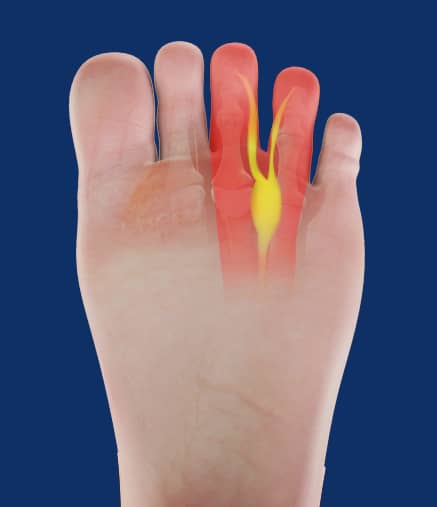
Our feet contain lots of nerves. Every time you drop something heavy on your foot or stub your toe reminds you of that fact.
External trauma like these, along with unavoidable genetic predispositions, can inflame the nerves in your feet and cause you plenty of pain and other problems.
One such nerve problem is called a neuroma.
What Exactly Is Morton’s Neuroma?
Sometimes called a “Morton’s Neuroma” or a “pinched nerve,” a neuroma refers to a benign growth of nerve tissue that most often most develops between the third and fourth toes.
It can cause pain, a burning sensation, tingling, or numbness between the toes and in the ball of the foot, especially when walking.
Women make up a disproportionate number of neuroma sufferers.
Why Do Neuromas Develop?
Typically, a neuroma will develop due to abnormal movement of the metatarsals, the long bones behind the toes.
Tiny nerves traverse the spaces of the metatarsals, splitting at the base of the toes and continuing into each individual toe.
The nerves at this fork in the toes can become pinched and swollen, forming a neuroma. Left untreated, this swelling can lead to permanent nerve damage.
What Treatments Are Available For Neuromas?
We can often treat neuromas with cortisone injections, orthotics, or chemical destruction of the nerve.
However, in more severe cases or if these non-invasive therapies fail to relieve the pain and inflammation, we may recommend surgery.
Neuroma surgery involves the removal of the enlarged and inflamed nerve, usually between the metatarsal heads in the ball of the foot.
In this outpatient procedure, the patient is given a local anesthetic or intravenous anesthesia.
The surgeon will then make a small incision on the top of the foot above where the neuroma is located, most often in the area between the second and third toes or between the third and fourth toes.
The troublesome nerve is then identified, cut, and removed from the foot. The incision is then closed with stitches, and a dressing is applied to protect the area from infection and irritation.
During the first two to four weeks after neuroma surgery, patients can usually walk on the treated foot in a post-surgical shoe.
During that time, patients should try to keep the foot elevated (above heart level) and stay off the foot as much as possible.
We’re Changing Lives Locally, Nationally and Globally!
Neuromas are just one of the foot and ankle problems we treat at JAWS Podiatry.
We will look at all possible alternatives to see if a non-surgical treatment can solve your problem.
If we do recommend surgery, our experienced podiatric surgeon will perform your operation with the highest level of care and precision, using the most advanced technology and methods.
Please send us a message, or call at (954) 922-7333 or to schedule a virtual or in-person consultation today!
- The Life-Changing Power of Cosmetic Foot Surgery - February 27, 2023
- What Are The Most Common Pediatric Foot Conditions? - October 5, 2020
- 4 Important Things To Know Before Having Foot Surgery - September 21, 2020



